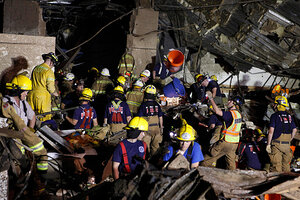Search and rescue efforts under way in Moore, Okla.
A monstrous tornado barreled Moore, Okla., Monday, demolishing an elementary school and a hundreds of homes. At least 24 people were killed. President Obama declared a major disaster and ordered federal aid to supplement state and local recovery efforts.

Oklahoma National Guard soldiers and rescue workers dig through the rubble of Plaza Tower Elementary school Tuesday after a devastating tornado ripped through Moore, Okla., Monday. The 2-mile wide tornado has killed at least 51 people and injured more than 200.
Courtesy of Sgt. 1st Class Kendall James/Oklahoma National Guard/Reuters
Moore, Okla.
Search and rescue crews worked through the night after a monstrous tornado barreled through the Oklahoma City suburbs, demolishing an elementary school and reducing homes to piles of splintered wood. At least 24 people were killed, including at least seven children, according to the medical examiner. Authorities initially said as many as 51 people were dead, including 20 children.
The storm stripped leaves off trees and left scores of blocks in Moore barren and dark. Rescuers walked through neighborhoods where Monday's powerful twister flattened home after home, listening for voices calling out from the rubble. A helicopter buzzed above, shining lights on crews below.
As Monday turned into Tuesday, the town of Moore, a community of 41,000 people 10 miles south of the city, braced for another long, harrowing day.
"As long as we are here ... we are going to hold out hope that we will find survivors," said Trooper Betsy Randolph, a spokeswoman for the Oklahoma Highway Patrol.
More than 120 people were being treated at hospitals, including about 50 children. Amy Elliott, spokeswoman for the Oklahoma Medical Examiner's Office, said Tuesday that there could be as many as 40 more fatalities from Monday's tornado.
On Monday evening, families anxiously waited at churches to hear if their loved ones were OK. A man with a megaphone stood near St. Andrews United Methodist Church and called out the names of surviving children. Children and parents hugged as they reunited. Other parents waited, hoping to hear their sons' and daughters' names as the night dragged on.
Crews continued their desperate search and rescue effort throughout the night at Plaza Towers Elementary, where the storm had ripped off the school's roof, knocked down walls and turned the playground into a mass of twisted plastic and metal as students and teachers huddled in hallways and bathrooms.
Children from the school were among the dead, but several students were pulled out alive from under a collapsed wall and other heaps of mangled debris. Rescue workers passed the survivors down a human chain of parents and neighborhood volunteers. Parents carried children in their arms to a triage center in the parking lot. Some students looked dazed, others terrified.
James Rushing, who lives across the street from the school, heard reports of the approaching twister and ran to the school where his 5-year-old foster son, Aiden, attends classes. Rushing believed he would be safer there.
"About two minutes after I got there, the school started coming apart," he said.
Another school, Briarwood Elementary, was also damaged by the tornado.
Oklahoma Gov. Mary Fallin deployed 80 National Guard members to assist with rescue operations and activated extra highway patrol officers. Fallin also spoke Monday with President Barack Obama, who declared a major disaster and ordered federal aid to supplement state and local recovery efforts.
President Barack Obama will be meeting with his disaster response team, including Homeland Security Secretary Janet Napolitano, on Tuesday before delivering a statement on the devastating tornado that tore through the Oklahoma City suburbs Monday.
Oklahoma-based Chesapeake Energy Corp. says it will donate $1 million to the American Red Cross to help in the rescue and recovery efforts in Moore.
The oil and gas company says it's also organizing hundreds of employee volunteers to help in the relief effort.
In video of the storm, the dark funnel cloud could be seen marching slowly across the green landscape. As it churned through the community, the twister scattered shards of wood, awnings and glass all over the streets.
A map provided by the National Weather Service showed that the storm began west of Newcastle and crossed the Canadian River into Oklahoma City's rural far southwestern side about 3 p.m. When it reached Moore, the twister cut a path through the center of town before lifting back into the sky at Lake Stanley Draper.
The National Weather Service issued an initial finding that the tornado was an EF-4 on the enhanced Fujita scale, the second most powerful type of twister.
The Storm Prediction Center in Norman, Okla., forecast more stormy weather on Tuesday, predicting golf ball-sized hail, powerful winds and isolated, strong tornadoes for parts of Texas, Arkansas, Louisiana and Oklahoma. The area at risk does not include Moore, Okla.
Monday's powerful tornado loosely followed the path of a killer twister that slammed the region with 300 mph winds in May 1999. It was the fourth tornado to hit Moore since 1998.
The weather service estimated that Monday's tornado was at least a half-mile wide.
Moore Mayor Glenn Lewis, who was also mayor during the 1999 storm, said the city was already at work on the recovery.
"We've already started printing the street signs. It took 61 days to clean up after the 1999 tornado. We had a lot of help then. We've got a lot of help now."
Monday's devastation in Oklahoma came almost exactly two years after an enormous twister ripped through the city of Joplin, Mo., killing 158 people and injuring hundreds more.
That May 22, 2011, tornado was the deadliest in the United States since modern tornado record keeping began in 1950, according to the National Oceanic and Atmospheric Administration. Before Joplin, the deadliest modern tornado was June 1953 in Flint, Mich., when 116 people died.
___
Associated Press writers Sean Murphy and Sue Ogrocki contributed to this report.
Copyright 2013 The Associated Press.

